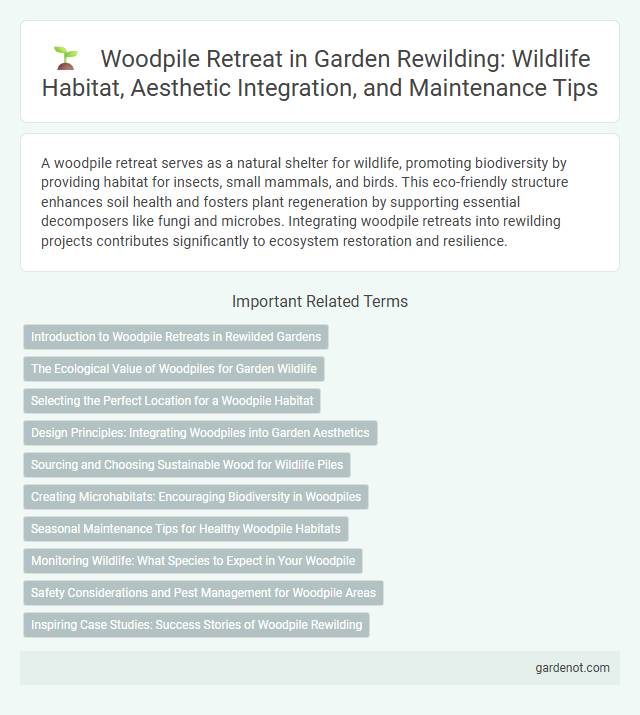A woodpile retreat serves as a natural shelter for wildlife, promoting biodiversity by providing habitat for insects, small mammals, and birds. This eco-friendly structure enhances soil health and fosters plant regeneration by supporting essential decomposers like fungi and microbes. Integrating woodpile retreats into rewilding projects contributes significantly to ecosystem restoration and resilience.
Introduction to Woodpile Retreats in Rewilded Gardens
Woodpile Retreats in rewilded gardens create immersive habitats that enhance biodiversity by providing shelter and food for native wildlife. These sustainable structures mimic natural decomposing wood, supporting insects, birds, and small mammals within a balanced ecosystem. Integrating woodpile retreats encourages ecological restoration and promotes environmental education through hands-on interaction with nature.
The Ecological Value of Woodpiles for Garden Wildlife
Woodpile retreats create essential habitats for a variety of garden wildlife, including insects, amphibians, and small mammals, promoting biodiversity and ecological balance. Decomposing wood in these piles supports fungi and invertebrates that enrich soil health and foster nutrient cycling. Maintaining woodpiles enhances local ecosystems by providing shelter, breeding grounds, and food sources critical to sustaining native species populations.
Selecting the Perfect Location for a Woodpile Habitat
Selecting the perfect location for a woodpile habitat involves choosing a site with ample shade, proximity to native trees, and minimal human disturbance to support biodiversity. Ideal spots include forest edges, near decomposing logs, or damp, sheltered areas that promote fungal growth and provide shelter for insects, amphibians, and small mammals. Ensuring the woodpile is positioned away from excessive moisture prevents rot while maintaining habitat stability essential for rewilding success.
Design Principles: Integrating Woodpiles into Garden Aesthetics
Woodpile retreats emphasize the seamless integration of woodpiles into garden aesthetics by using natural materials and organic shapes that complement surrounding vegetation and landscape features. Carefully stacked woodpiles serve as functional art, enhancing habitat diversity by providing shelter for insects, birds, and small mammals. Strategic placement near pathways or garden beds creates visual interest while promoting ecological balance and sustainability within the outdoor environment.
Sourcing and Choosing Sustainable Wood for Wildlife Piles
Woodpile retreats prioritize sourcing sustainably harvested wood to create vital habitats for wildlife, promoting biodiversity by providing shelter and food for insects, birds, and small mammals. Selecting locally reclaimed or deadwood ensures minimal environmental impact while supporting natural decomposition processes crucial for soil health. Choosing diverse wood species and sizes enhances habitat complexity, benefiting a wide range of organisms within rewilding projects.
Creating Microhabitats: Encouraging Biodiversity in Woodpiles
Woodpile retreats enhance biodiversity by creating essential microhabitats that support a variety of insects, amphibians, and small mammals. These woodpiles maintain moisture and temperature variations, fostering fungi growth and providing shelter for decomposers crucial to nutrient cycling. Strategic placement and diversity of wood types further increase habitat complexity and promote ecological resilience.
Seasonal Maintenance Tips for Healthy Woodpile Habitats
Regularly monitoring moisture levels in a woodpile is essential for preventing mold and promoting habitat health, as damp conditions can lead to decay and deter beneficial wildlife. Clearing debris and ensuring good air circulation around the woodpile supports natural predator and pollinator presence, enhancing the biodiversity of rewilded areas. Rotating and layering wood properly maintains structural stability and provides diverse shelter options for insects, amphibians, and small mammals essential to balanced ecosystems.
Monitoring Wildlife: What Species to Expect in Your Woodpile
Woodpile retreats create essential habitats for diverse wildlife, including amphibians like salamanders and toads, small mammals such as mice and shrews, and a variety of insects like beetles and spiders. Bird species often observed include woodpeckers and wrens that forage for insects within the decaying wood. Regular monitoring reveals seasonal fluctuations in species presence, reflecting woodpile health and local biodiversity in rewilding efforts.
Safety Considerations and Pest Management for Woodpile Areas
Woodpile retreats require rigorous safety measures to prevent fire hazards and structural collapse, ensuring secure stacking and regular inspections. Effective pest management involves monitoring for infestations of termites, rodents, and insects that can damage wood and pose health risks. Utilizing natural repellents and maintaining dryness around woodpiles reduces pest attraction while promoting a safe, sustainable rewilding environment.
Inspiring Case Studies: Success Stories of Woodpile Rewilding
Woodpile Retreat exemplifies successful rewilding by restoring biodiversity through natural wood decomposition habitats that support diverse wildlife populations. Their approach integrates traditional forest management with innovative ecological practices, resulting in increased native species and improved soil health. This case study highlights measurable ecological recovery, serving as a benchmark for sustainable ecosystem restoration projects.
Woodpile retreat Infographic

 gardenot.com
gardenot.com